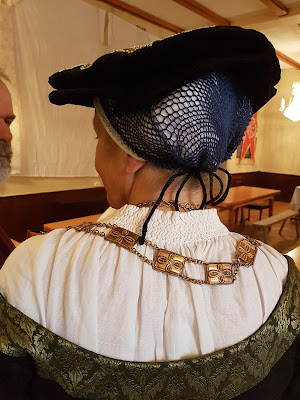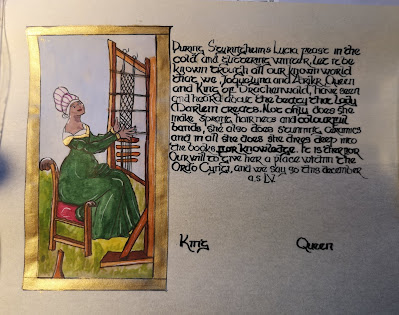I have been to an event! Finally. I had not understood how much I have missed my people but seeing them all again made it very clear. I need events. As last time there was a Lucia event in Styringheim, a barony in Nordmark, Drachenwald, the head of my household where autocrat and the rest of us helped where every we where needed.
And I know, I have not been writing anything here as in for ever. The side effect of starting my own business is that I mostly make the same things over and over again and only for other people, so there are not much time to make research and to make things for me. But I still need a new dress, so sooner or later there will be one made. And I have a lovely hairnet with a embroidered border inspired by a painting of Catharine von Bora, the wife of Martin Luther, in the making and that one deserves its own article here.
Except that is was great fun seeing everybody again there were extra fun to see my hairnets in use. The always so beautiful Tece de Kaxtorn were using a blue linen net that I made.
Here she is using it with a hat on top. A very proper way to wear the hairnets. Its very common in renaissance paintings to see hairnet being used together with a hat. More common actually to wear a hairnet and hat than a steuchline and a hat in 16th century Germany.
Its also fun to see that she is wearing a wulst in a smaller size. Often among reenactors a big wulst is the most common. But if you look at the actual fashion the big wulst is only common in the beginning of the 16th century. To be replaced by a much smaller one around 1515-20.
Not only are the wulst getting smaller in size, they tend to lean a bit backwards. I dont look good in that kind of wulst, it does not suit my head, but Tece does!
At the event were also this gentleman, Edricus filius Offaeus. He is wearing a 16th century sprang hairnet in black linen.
The hairnet make the hat stay on much better and, besides that, it look good, right!?
Hairnet on men where very common during the 16th century but not that many reenactors have one. That might be because there are not that many of us making male hairnets. And not many men today feel comfortable in them. To bad I say, when it makes an outfit come together in such a lovely way.
Here me and Renike is putting up some decorations. Im wearing a sleeveless unterrock, its the underdress, and an apron in wool. I forgot my apron in linen, much more suitable for kitchenwork. She is wearing German late 15th century, with a Lengberg cap that I made, an apron in linen often seen on midwifes in paintings and yellow wool sleeved overdress.
There were a court on Friday evening too. And I had the honor to be elected into the order of the rings, Ordo Cygni. The rare companions in Ordo cygni (the Company of the Swan) have distinguished themselves by superior achievement in scholarship, the arts and the advancement of beauty and knowledge in Drachenwald. They took me by surprise but made me very happy. The scroll is made by Agnes Odygd. Look, isn't it amazing?
I will end this with showing a picture of the autocrat-team, taken on Saturday evening, after the last serving. Tired but happy! Head autocrat Renike Tucher in yellow, Görvel Skote, head of the food, in green. Sigrid, head of the kitchen on site, in red. And me, in red and black. The food was as always amazing. We served 7 different kinds of pie. One of each for everyone. I saw all the plates go out, and all of them look like small pieces of art. Im so impressed by Renike and Görvel who made all of them.
Edit - There is a picture of myself at court and I got an ok to show it to you here. So, here comes an extra picture. Im wearing one of my hairnets, a silk striped one. Danel took this picture. The court at friday evening is as you can see inside, and not in the ruin.


















































